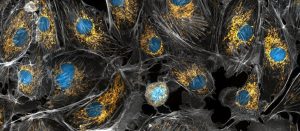Enter your address to receive notifications about new posts to your email.
Articles tagged G3 Journal
(226 results)
-
Protein variance in tightly controlled developmental processes
Take two neighboring cells from the same tissue—cells that are about as identical as any could be. Despite their similarities, these two cells could actually vary massively in their transcriptome. The typical fate of an mRNA—the “transcript” in transcriptome—is to serve as a template to make a protein, but it isn’t clear that the differences…
-
New in G3: unstable inheritance, chromosomal translocation, and meiotic silencing
Check out the April issue of G3! Table of Contents Mutant Screen Report Identification of Genes in Saccharomyces cerevisiae that Are Haploinsufficient for Overcoming Amino Acid Starvation Nancy S. Bae, Andrew P. Seberg, Leslie P. Carroll, Mark J. Swanson G3: Genes, Genomes, Genetics April 2017 7: 1061-1084; https://doi.org/10.1534/g3.116.037416 Investigations A Whole-Transcriptome Approach to Evaluating Reference…
-
Incompatibility between mitochondrial and nuclear genomes isolates many nematode populations
Constant mutation and shaping by natural selection can make the once-identical genomes of isolated populations of organisms very different from one another. This genetic divergence can lead to two such populations no longer being able to interbreed successfully—speciation. In their paper in the March issue of G3, Lamelza and Ailion show that harmful interactions between…
-
New in G3: bone geometry, lysosome function, and single-molecule sequencing
Check out the March issue of G3! Table of Contents Investigations Genomic Regions Associated with Tolerance to Freezing Stress and Snow Mold in Winter Wheat Erika B. Kruse, Scott W. Carle, Nuan Wen, Daniel Z. Skinner, Timothy D. Murray, Kimberly A. Garland-Campbell, Arron H. Carter G3: Genes, Genomes, Genetics March 2017, 7: 775-780; DOI: https://doi.org/10.1534/g3.116.037622…
-
Brighter GFP gets the green light
Off the coast of North America drifts a jellyfish that has unknowingly revolutionized molecular biology. Aequorea victoria produces green fluorescent protein (GFP), a substance that adds a green tinge to the jelly’s bioluminescence, which can sometimes be seen around its margins. By inserting a slightly modified version of the GFP gene into the genomes of…
-
New in G3: a beaver genome, some sparkling yeast, and neon proteins
Check out the February issue of G3! Table of Contents Genome Report Genome Report: Identification and Validation of Antigenic Proteins from Pajaroellobacter abortibovis Using De Novo Genome Sequence Assembly and Reverse Vaccinology Bryan T. Welly, Michael R. Miller, Jeffrey L. Stott, Myra T. Blanchard, Alma D. Islas-Trejo, Sean M. O’Rourke, Amy E. Young, Juan F.…
-
Behind the cover: Oh Canada!
February marks the launch of a crisp new look and improved navigation at the G3 website. Go check it out; we’re very proud of the design! We are also unveiling a new cover layout that allows the art submitted by our authors to shine. This month’s cover celebrates the first published genome assembly of the Canadian…
-
In the Year of the Rooster, a new chicken genome assembly is hatched
The chicken is one of humanity’s closest and oldest allies. With a worldwide population in the billions, this former jungle fowl is one of the most important domesticated animals on Earth. In the February issue of G3, Warren et al. further our understanding of this familiar bird, presenting a new and substantially improved chicken genome assembly…
-
Beyond stressed-out: the hypoxic response
Deep within a tumor, sequestered from an adequate blood supply, a cancer cell grows and multiplies. Far beneath Earth’s surface, a microbe lives and thrives in similarly low-oxygen conditions. Generally, oxygen depletion causes serious distress to aerobic organisms—what allows these life forms to survive? The cellular response to hypoxia is massive. Hypoxia alters the expression…
-
Pathogenic yeast uniquely resists toxicity of aggregation-prone proteins
Misfolded proteins can be so toxic that they cause cell death. At least nine neurodegenerative disorders are caused by misfolded proteins with expanded stretches of glutamine residues (polyQ tracts), including the invariably fatal Huntington’s disease. But some organisms are resistant to the harmful effects of these proteins. In the January issue of G3, Leach et…
-
Enhancer-promoter distance is a potent modulator of gene expression
To boost transcription of a target gene, enhancer sequences must make contact with the gene’s promoter. This crucial meeting is mediated by interacting proteins and the formation of chromatin loops that bring distant enhancers and promoters together. Although it’s clear that enhancers increase transcription this way, the primary mechanisms by which an enhancer’s target genes…





![By Jim G from Silicon Valley, CA, USA [CC BY 2.0], via Wikimedia Commons](https://s36063.pcdn.co/wp-content/uploads/2017/02/dsc26476-_crystal_jelly_-aequ-300x225.jpg)




![By Kelvinsong (Own work) [CC BY 3.0], via Wikimedia Commons. (Modified)](https://s36063.pcdn.co/wp-content/uploads/2017/01/rsz_transcription_factors-300x163.png)